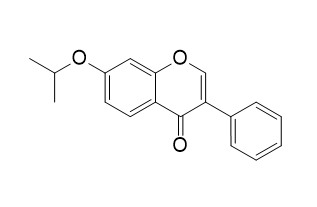Ipriflavone
Ipriflavone plays a direct role in modulating the synthetic and growth properties of osteoblast‐like cells. Ipriflavone directly stimulates markers of the osteoblast phenotype at a certain stage in bone formation without affecting undifferentiated cells that have not been committed to the osteogenic lineage.
Inquire / Order:
manager@chemfaces.com
Technical Inquiries:
service@chemfaces.com
Tel:
+86-27-84237783
Fax:
+86-27-84254680
Address:
1 Building, No. 83, CheCheng Rd., Wuhan Economic and Technological Development Zone, Wuhan, Hubei 430056, PRC
Providing storage is as stated on the product vial and the vial is kept tightly sealed, the product can be stored for up to
24 months(2-8C).
Wherever possible, you should prepare and use solutions on the same day. However, if you need to make up stock solutions in advance, we recommend that you store the solution as aliquots in tightly sealed vials at -20C. Generally, these will be useable for up to two weeks. Before use, and prior to opening the vial we recommend that you allow your product to equilibrate to room temperature for at least 1 hour.
Need more advice on solubility, usage and handling? Please email to: service@chemfaces.com
The packaging of the product may have turned upside down during transportation, resulting in the natural compounds adhering to the neck or cap of the vial. take the vial out of its packaging and gently shake to let the compounds fall to the bottom of the vial. for liquid products, centrifuge at 200-500 RPM to gather the liquid at the bottom of the vial. try to avoid loss or contamination during handling.
AMB Express2020. 10(1):126.
Pak J Pharm Sci.2023, 36(1):51-57.
Horticulture Research2023, uhad164.
Appl. Sci.2020, 10,1304
BMC Complement Altern Med.2017, 17(1):384
Int J Mol Sci.2021, 22(21):11447.
Pharmacol Res.2020, 161:105205.
Mol Biol Rep.2022, doi: 10.1007
Br J Pharmacol.2020, 10.1111
Research Square2024, rs-4398438
Related and Featured Products
Journal of Bone & Mineral Research, 2010, 9(3):395-400.
Effect of ipriflavone on expression of markers characteristic of the osteoblast phenotype in rat bone marrow stromal cell culture.[Pubmed:
8191934]
The effects of Ipriflavone on cellular proliferation and differentiation of osteoblasts were investigated using stromal cells isolated from the femoral bone marrow of young rats.
METHODS AND RESULTS:
To induce the formation of mineralized bone-like tissue in vitro, the cells were cultured in the presence of beta-glycerophosphate and dexamethasone. Ipriflavone was added when subculturing was started. After 14 days of culturing with Ipriflavone (10(-7)-10(-5) M), increases in both the alkaline phosphatase activity and the hydroxyproline content per culture dish and a slight decrease in the saturated cell density were observed. Furthermore, continuous treatment with Ipriflavone for 14-33 days resulted in an increase in the area of bone-like mineralized tissue accompanied by an increase in the secretion of osteocalcin. When culture medium lacking dexamethasone was used, rat bone marrow stromal cells neither differentiated into osteoblasts nor formed bone-like tissue, and under these conditions, Ipriflavone had no effect on the proliferation or the phenotypic expression of the cells.
CONCLUSIONS:
These results suggest that Ipriflavone directly stimulates markers of the osteoblast phenotype at a certain stage in bone formation without affecting undifferentiated cells that have not been committed to the osteogenic lineage.
Jama, 2001, 285(11):1482-8.
Ipriflavone in the treatment of postmenopausal osteoporosis: a randomized controlled trial.[Reference:
WebLink]
Data on the efficacy and safety of Ipriflavone for prevention of postmenopausal bone loss are conflicting.To investigate the effect of oral Ipriflavone on prevention of postmenopausal bone loss and to assess the safety profile of long-term treatment with Ipriflavone in postmenopausal osteoporotic women.
METHODS AND RESULTS:
Prospective, randomized, double-blind, placebo-controlled, 4-year study conducted in 4 centers in Belgium, Denmark, and Italy from August 1994 to July 1998.Four hundred seventy-four postmenopausal white women, aged 45 to 75 years, with bone mineral densities (BMDs) of less than 0.86 g/cm(2).Patients were randomly assigned to receive Ipriflavone, 200 mg 3 times per day (n = 234), or placebo (n = 240); all received 500 mg/d of calcium.Efficacy measures included spine, hip, and forearm BMD and biochemical markers of bone resorption (urinary hydroxyproline corrected for creatinine and urinary CrossLaps [Osteometer Biotech, Herlev, Denmark] corrected for creatinine), assessed every 6 months. Laboratory safety measures and adverse events were recorded every 3 months.Based on intent-to-treat analysis, after 36 months of treatment, the annual percentage change from baseline in BMD of the lumbar spine for Ipriflavone vs placebo (0.1% [95% confidence interval (CI), -7.9% to 8.1%] vs 0.8% [95% CI, -9.1% to 10.7%]; P =.14), or in any of the other sites measured, did not differ significantly between groups. The response in biochemical markers was also similar between groups (eg, for hydroxyproline corrected for creatinine, 20.13 mg/g [95% CI, 18.85-21.41 mg/g] vs 20.67 mg/g [95% CI, 19.41-21.92 mg/g]; P =.96); urinary CrossLaps corrected for creatinine, 268 mg/mol (95% CI, 249-288 mg/mol) vs 268 mg/mol (95% CI, 254-282 mg/mol); P =.81. The number of women with new vertebral fracture was identical or nearly so in the 2 groups at all time points. Lymphocyte concentrations decreased significantly (500/microL (0.5 x 10(9)/L]) in women treated with Ipriflavone. Thirty-one women (13.2%) in the Ipriflavone group developed subclinical lymphocytopenia, of whom 29 developed it during Ipriflavone treatment. Of these, 15 (52%) of 29 had recovered spontaneously by 1 year and 22 (81%) of 29 by 2 years.
CONCLUSIONS:
Our data indicate that Ipriflavone does not prevent bone loss or affect biochemical markers of bone metabolism. Additionally, Ipriflavone induces lymphocytopenia in a significant number of women.



